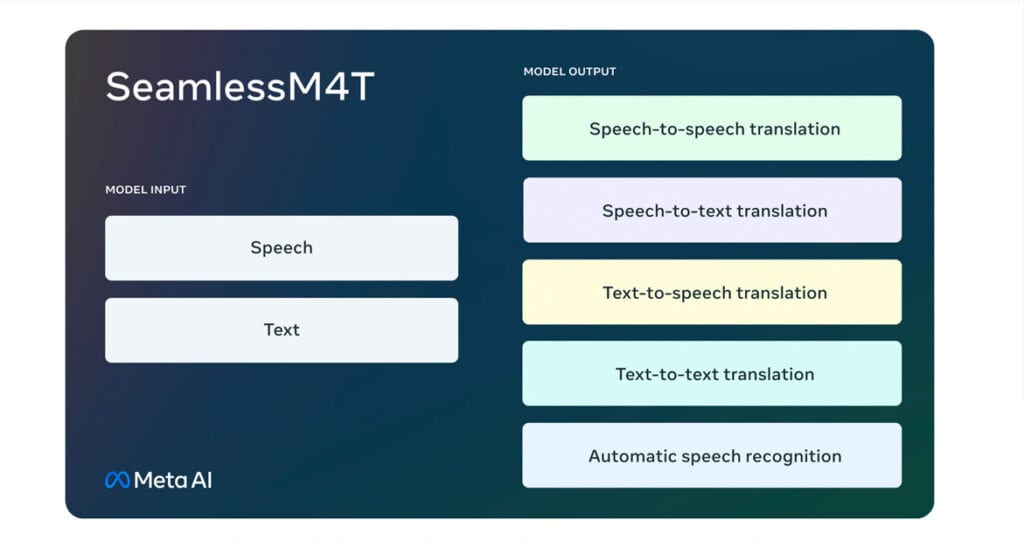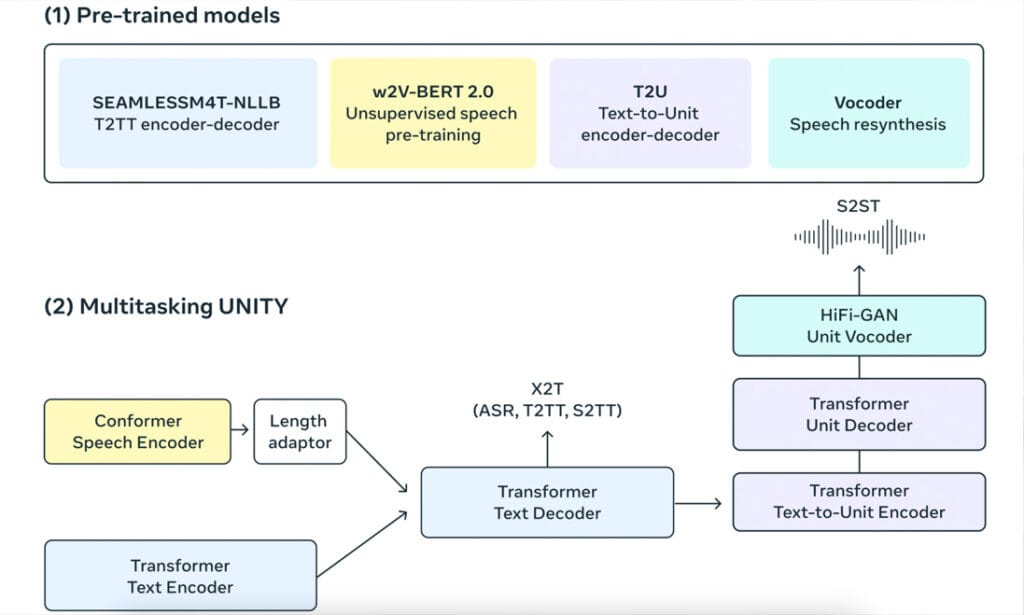Meta’s AI Translator Seamless M4T
Meta’s AI Translator Seamless M4T
Bridging Language Divides and Enabling Global Communication
In a dedicated stride toward breaking down linguistic barriers and fostering global connections, Meta has unveiled its remarkable AI translator, known as Seamless M4T. This advanced multilingual foundational model possesses the extraordinary capability to comprehend nearly 100 languages from both spoken and written inputs, seamlessly generating real-time translations in either format, or even both.
Introducing Seamless M4T: A Multimodal Marvel
Labeled as Seamless M4T, this pioneering multimodal technology has been publicly introduced with the intent of empowering researchers to further enhance its capabilities and introduce universal applications adept at delivering a spectrum of translations—speech-to-speech, speech-to-text, text-to-speech, and text-to-text. Along with the release, Seamless align, a sizable multimodal translation dataset with an outstanding 265,000 hours of carefully curated speech and text alignments, is also available.
Language Applications of AI Advance
The combined effort of AI and linguistics has just made a significant step with this announcement. Unlike prior methodologies that relied on separate systems for distinct tasks, Seamless M4T functions as a cohesive system adept at handling multifarious functions spanning both speech and text domains. This is a notable shift from the traditional method that required several systems, including a system specifically for speech-to-speech translations.
The Proficiency of Seamless M4T
According to Meta, Seamless M4T inherently discerns the source language without necessitating a distinct language identification model. It adeptly identifies speech and text across a vast array of languages, facilitating translations in nearly 100 languages in text and 36 languages in speech. A particularly intriguing aspect of its capabilities lies in its aptitude to decipher sentences amalgamating multiple languages. It proficiently furnishes translations targeted at a single language, even if the original sentence blends multiple languages. For instance, it can adeptly handle a sentence combining Telugu and Hindi, rendering it in fluent English speech.
Validation Through Performance: A Edge of Meta Translator Seamless M4T
Seamless M4T underwent thorough testing using BLASER 2.0, an evaluation framework encompassing speech and text units.
On average, its performance outperformed current state-of-the-art models by significant margins, displaying improvements of 37% and 48% against these challenges.
In a triumphant blog post, Meta confidently stated that Seamless M4T surpasses its predecessors., showcasing augmented performance for low and mid-resource languages, alongside unwavering excellence for high-resource languages like English.
Making Way for Broad Communication
The development of Seamless M4T signals the potential for the implementation of universal translation technologies on a large scale, enabling effective communication between people speaking different languages.
Intriguingly, Google is also steering its efforts in this direction, with the introduction of the Universal Speech Model (USM) designed to facilitate automatic speech recognition for both widely spoken and under-resourced languages.
Decoding the Inner Mechanics
The journey to bring Seamless M4T to fruition entailed mining an extensive corpus of web data—comprising tens of billions of sentences—and speech data totaling a staggering 4 million hours. Meta meticulously aligned this data, culminating in the creation of the robust Seamlessalign dataset. This comprehensive dataset encompasses over 443,000 hours of meticulously aligned speech-text pairs, including approximately 29,000 hours of speech-to-speech alignments. Employing this rich dataset, Meta harnessed the power of a multitask UnitY model to achieve the desired multimodal outcomes.
Progressing Toward Excellence: Seamless M4T
While Seamless M4T presents remarkable strides, it’s crucial to acknowledge that perfection has not yet been attained. Evaluation reveals the model’s susceptibility to toxicity (albeit 63% less than state-of-the-art models) and gender bias issues. Importantly, when translating from neutral terms, Seamless M4T tends to overgeneralize to masculine forms, displaying an average preference of around 10%. It also exhibits a certain fragility when it comes to varying gender, with an approximately 3% variance.
It is admirable how proactive Meta has been in addressing these issues. The technology’s active detection of toxicity in input and output is described in the company’s whitepaper.
In cases where toxicity is identified only in the output, a warning is issued, and the output is withheld. As for gender bias, Meta has undertaken a significant effort to evaluate and quantify gender bias across various languages, extending its approach from text to speech through the Multilingual HolisticBias dataset.
Undeniably, Meta underscores its unwavering commitment to research and action, ensuring the ongoing refinement of the Seamless M4T model’s robustness and safety.
Meta’s AI Translator Seamless M4T, which radiates technological excellence, enables communication to surpass language boundaries and bring together individuals from diverse linguistic backgrounds, creating a world of unity.
FAQ:
What is Meta’s AI Translator Seamless M4T?
Meta’s AI Translator Seamless M4T is an advanced technology that serves as a multilingual foundational model. It can comprehend almost 100 languages from speech or text inputs and generate real-time translations in both formats.
2. What benefit does Seamless M4T provide for multilingual applications?
Researchers can create global apps that can translate from text to speech, text to text, and speech to text using Seamless M4T.
3. Can Seamless M4T handle mixed language sentences?
Yes, Seamless M4T is adept at recognizing when multiple languages are combined in a sentence.
4. How well does Seamless M4T perform in evaluations?
When tested using BLASER 2.0, Seamless M4T exhibited impressive performance against background noise and speaker variations in speech-to-text tasks. Its average improvements of 37% and 48%, respectively, surpassed current state-of-the-art models.
5. What are the potential applications of Seamless M4T?
Large-scale universal translation systems can now be implemented thanks to the development of Seamless M4T
Other text-to-speech softwares
Affiliate Disclosure: Please note that this article may contain affiliate links, and I may earn a commission.







